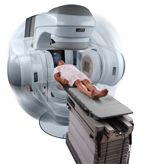Boost in Use of Latest Technologies for Low-Risk Prostate Cancer Patients
From 2004 to 2009, use of advanced treatment technologies increased among prostate cancer patients with low-risk disease and high risk of noncancer mortality.
A new study found that from 2004 to 2009, the use of advanced technologies for prostate cancer patients with low-risk disease has increased from 32% to 44%, and from 36% to 57% among men with high risk of noncancer mortality. The use of new modalities among all patients who are unlikely to die from their prostate cancer went from 13% to 24%. This translates to an increase of 115 out of every 1,000 patients diagnosed with prostate cancer.

RapidArc intensity-modulated radiation therapy (IMRT) system; © Varian Medical Systems, Inc
“The observed increase in use of these advanced treatment technologies occurred during a period of time in which there was a growing understanding of the indolent nature of some forms of prostate cancer,” said study author Brent K. Hollenbeck, MD, department of urology, University of Michigan, Ann Harbor, Michigan.
The new treatment modalities included intensity-modulated radiotherapy (IMRT) and robotic prostatectomy. Results of the study were published in the latest issue of JAMA.
Hollenbeck and colleagues retrospectively examined Surveillance, Epidemiology, and End Results (SEER)–Medicare data from patients 66 years old and older to understand the use of expensive, novel technologies compared to standard techniques among men who are unlikely to die from their prostate cancer.
The findings can be extended to the overall Medicare population, and similar trends could also be present among the younger prostate cancer population, said Hollenbeck. The SEER data used is the most up-to-date data available for prostate cancer treatment trends in the Medicare population, according to Hollenbeck.
The newer modalities largely substituted for prior standard prostate techniques, open prostatectomy and conformal radiation therapy, said Hollenbeck. Application of IMRT accounted for the majority of the increase in new technologies. The use of IMRT was highest among men who stand to have the least to gain.
The SEER data used in the analysis included 23,633 men who underwent IMRT; 3,926 who underwent traditional external beam radiation treatment (EBRT); 5,881 who had robotic prostatectomy; and 6,123 who had open radical prostatectomy. A total of 16,384 men who were undergoing observation or active surveillance were also included in the study.
Low risk disease was defined as Gleason score of 6 or less, prostate-specific antigen of 10 ng/mL or less, and clinical stage of T2a or less. A high risk of noncancer mortality was the predicted probability of death within 10 years in the absence of a diagnosis of cancer.
“Aggressive direct-to-consumer marketing and incentives associated with fee-for-service payment may promote the use of these advanced treatment technologies,” state the authors.
The authors highlighted the importance of understanding treatment trends in the context of increasing concern about overtreatment of patients with indolent and low-risk disease. An effort to distinguish between aggressive and indolent disease to lower unnecessary treatments, particularly with high-cost, advanced treatments is ongoing. Additionally, there is a need for better methods to predict the life expectancy of those diagnosed with prostate cancer.
“Medicare beneficiaries and other men at low risk of dying from their prostate cancer (as determined by low risk disease, a high risk of noncancer mortality, or both) should clarify the risks and benefits of treatment, as opposed to observation, with their doctors,” said Hollenbeck.